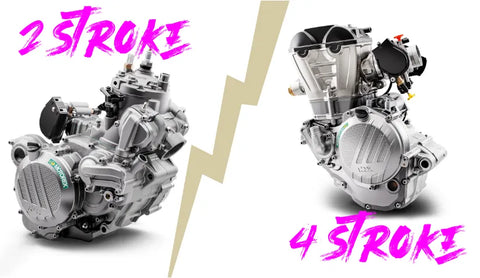Overview: The main power source of the car is the internal combustion engine. The concept of the internal combustion engine is very simple, it is a fuel burning inside the machine, converting heat energy directly into power. The internal combustion engine in the general sense refers to the piston internal combustion engine. Piston internal combustion engines are divided into four-stroke internal combustion engines and two-stroke internal combustion engines according to the number of strokes. So what's the difference between a four-stroke engine and a two-stroke engine? Which is better?

First of all, to understand the concept, the first stroke of a two-stroke engine is the inlet mixture and mixture compression; The second stroke is to do work and exhaust. A two-stroke engine performs four actions in two strokes. The four strokes of the four-stroke engine are the intake stroke, the compression stroke, the work stroke, and the exhaust stroke, and each action is completed by a separate stroke. The so-called four-stroke engine refers to the engine crankshaft every two weeks, through the intake, compression, work, and exhaust four strokes to complete a working cycle, while the two-stroke engine only needs the crankshaft to rotate one week, through two strokes to complete a working cycle.
The lubrication system of the two-stroke engine is relatively simple and rough and can not be as precise as that of the four-stroke engine, and the wear degree of the engine components is larger than that of the four-stroke engine for a long time, so the two-stroke engine is not as good as the four-stroke engine in terms of engine operation durability.
Due to the structural disadvantage of the two-stroke engine lubrication system, the lubrication effect is higher for lubricating oil, which also means that the cost of lubricating oil in the two-stroke engine will be more expensive than that of the four-stroke engine. Two-stroke engines work only two strokes, four-stroke engines have four strokes, and two-stroke engines are at a disadvantage in the precise control of each action, which also leads to the fuel economy of two-stroke engines is not as good as that of four-stroke engines.

The working principle of the two-stroke engine and the structure of its lubrication system must burn more lubricating oil than the four-stroke engine while burning fuel, which will not only generate carbon deposits in the cylinder and cause a series of bad consequences but also more exhaust pollutants, so the two-stroke engine is not as environmentally friendly as the four-stroke engine.
From the structural point of view, the structure of the two-stroke engine is relatively simple, mainly composed of a cylinder head, cylinder, piston, piston ring, and other parts, and there are intake holes, exhaust holes, and change holes in the cylinder block; The opening and closing of the stomata are determined by the position of the piston. Compared with the four-stroke engine, there is no complex valve mechanism and lubrication system, and the cooling system is generally air-cooled, which is greatly simplified in structure.
For the four-stroke engine, every two weeks of engine crankshaft rotation, intake, compression, work, and exhaust four strokes to complete a working cycle, while the two-stroke engine only needs the crankshaft to rotate one week, through two strokes to complete a working cycle. Due to differences in structure and working principle, the performance of four-stroke engines and two-stroke engines is also different.
From the performance point of view, when the crankshaft speed is the same, the number of work per unit time of the two-stroke engine is twice that of the four-stroke engine. In theory, the power of the two-stroke engine should be twice that of the four-stroke engine (but in fact, it is only 1.5 to 1.7 times), the liter power of the engine is higher, the power is better, and the vibration of the engine is relatively small. In addition, the two-stroke engine is relatively light in weight, low in manufacturing cost, lower in failure rate, more convenient in maintenance, and more convenient and flexible in use.

However, the two-stroke engine also has a lot of disadvantages, mainly the higher fuel consumption. Due to the poor air exchange quality of the two-stroke engine, the fuel efficiency is not high, and the fuel consumption of the vehicle is relatively high. In terms of exhaust emissions, the pollution of two-stroke engines is also very large, and the exhaust pollution of a two-stroke motorcycle engine with a displacement of 50ml is roughly equivalent to that of five 2.0L car engines.
Summary: In summary, four-stroke engines are more widely used, the vast majority of automobiles and construction machinery are equipped with four-stroke engines, and two-stroke engines are more used in those infrequent use, and "thrust-weight ratio" is a very important occasion. For example, lawnmowers, chainsaws, airplane models, agricultural machinery, etc., and some small motorcycles and cross-country motorcycles that pay more attention to power performance are also widely used. There are tanks, ships, heavy transport vehicles, etc., these models have high requirements for the power of the engine, and require the lightweight and small size of the engine, and the two-stroke engine is a good choice.
If you still have questions about this or if you have a different point of view, you can contact me and I can provide you with quality guaranteed engine parts.
















